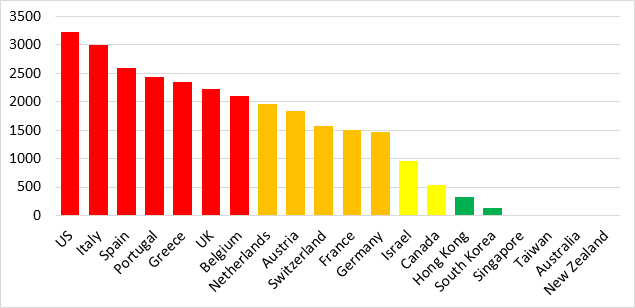Britain’s pandemic response revisited: has “Plague Island” redeemed itself?
SUGGESTED



Viral Myths was mostly a critique of “Coronfirmation Bias”, i.e. the tendency of a lot of commentators to interpret the pandemic as a vindication of their own worldview, and a validation of their own pet obsessions. In some cases, this had led to demonstrably false claims becoming part of the conventional wisdom. The paper, in other words, was less about the pandemic as such, and more about the long-term impact it might have on the climate of opinion.
Nonetheless – it did include a fairly negative assessment of the way Britain had dealt with the pandemic to date. There is generally no straightforward way of saying whether a country has done a “good job” or a “bad job” in coping with Covid, because it depends on what we mean by that. What counts as “success”? Does it just mean a low Covid death rate? Or are the broader objectives, too? What about other health outcomes? Economic outcomes? Preserving civil liberties, and a sense of a normal life?
In Britain’s case, however, the situation was rather unambiguous. Britain was doing badly across the board. Our Covid death rates and excess mortality rates were among the highest in the developed world, our Covid-recession was one of the steepest, and our lockdown measures were no less intrusive than those of our neighbours.
That, at least, was the situation a year ago, when the paper came out. Shortly after, however, it looked as if the tide was turning. Britain became a world leader in the vaccine rollout. By mid-year, two thirds of the population had received their first jab, and half of the population were double-jabbed.
The number of Covid deaths dropped like a stone. It would later moderately rise again, but from now on, it would stay below the EU average for most of the time.
As a result, Britain could be bolder than most of its neighbours in easing lockdown restrictions. The German Bild newspaper now regularly commented jealously on Britain’s roadmap back to normality. (“Dear Brits: we envy you!”; “While the Brits are already planning their summer holidays, Germany is still stuck in lockdown”), not failing to single out the opening of the beer gardens. It seemed like an almost complete reversal of fortune. “Plague Island” had become beer garden island.
Despite dire warnings from “Covid hawks” every time a restriction was eased, Britain held its nerve. It turned out to be the right decision. Covid had become manageable, the British economy recovered, and daily life returned to something resembling normality.
Britain – or at least England – also largely held its nerve during the Omicron wave, when many of our neighbours panicked. Britain’s measured response to that variant contrasts favourably with the headless-chicken-responses of, especially, France and Germany, which immediately brought in disproportionate new restrictions. Pointlessly so, as it turned out. Germany merely delayed the inevitable by a about month, and then experienced an Omicron wave of almost exactly the same magnitude as Britain. France went on to experience a far bigger wave.
All in all, it is fair to say that after a terrible first year of the pandemic, Britain made up some lost ground in the second year. Does this mean that we have to revise the initial pessimistic assessment? Was the much-maligned “Plague Island” a belated success story, after all?
The short answer is: not quite.
For a start, if we look at cumulative excess death rates in high-income countries, Britain remains part of the top group, with over 2,200 excess deaths per million people. Britain’s fast vaccine rollout meant that the death toll did not escalate much further over the past year. But it could obviously not retroactively undo the damage that had already been done.
Cumulative excess deaths per 1m since the outbreak of Covid-19

–The Economist excess death tracker (2022)
How about the economic situation?
Boris Johnson recently boasted that “We now have […] the fastest growing economy in the G7”, which is technically true, but then, we also had a steeper fall in 2020, so the base effect alone was always going to make any rebound look bigger. What matters is where we are relative to the pre-pandemic level, and those figures look less impressive. The British economy has bounced back to where it was in 2019, which is great, but other advanced economies have already moved beyond that.
GDP per capita in international/PPP-adjusted $

In the Spring of 2021, Britain was about 30 percentage points ahead of the EU in terms of vaccination rates. But once the EU finally got its act together on vaccine purchases, the gap began to close. By the middle of the year, it had halved, and shortly after, the Netherlands, Belgium, Portugal, Ireland, France, Finland and Italy overtook Britain.
The speed with which Covid restrictions were eased loosely followed the speed of the vaccine rollout. Britain was initially bolder in opening up, but we did not sustain that lead for long. If I had to relive the Spring of 2021, and could choose any European country to be in, I would want to be in Britain. But if I had to relive the summer or the or autumn of the same year, I would not be so sure where I would want to go.
So yes, over the period as a whole, Britain’s pandemic response looks less bad than it did at halftime. But we are not talking about a Jamie Lannister-type character arc, where an initial villain later becomes a hero. We are talking about someone more like Sandor “the Hound” Clegane, who starts off as a baddie, who later surprises the audience by becoming a bit more likeable, but who, all things considered, still remains quite clearly on the bad side.
3 thoughts on “Britain’s pandemic response revisited: has “Plague Island” redeemed itself?”
Comments are closed.





“In the Spring of 2021, Britain was about 30 percentage points ahead of the EU in terms of vaccination rates. But once the EU finally got its act together on vaccine purchases, the gap began to close. By the middle of the year, it had halved, and shortly after, the Netherlands, Belgium, Portugal, Ireland, France, Finland and Italy overtook Britain.”
Kristian, this is slightly misleading. The reason why ‘raw’ vaccination rates in some other European countries overtook that of the UK is twofold. Firstly, many decided to vaccinate children before we did (we were more cautious since vaccination has few direct benefits to children and alway carries a slight degree of risk). However, our vaccination rates in older (and more vulnerable) people remained ahead. Secondly, the measure of vaccination rates compared ‘full vaccination’ rates, i.e. two doses. It did not include booster doses, which we rolled out early in preference to vaccinating children. If you look not at the ‘Full vaccination’ rate by country but instead at the ‘Number of vaccination doses per 100 people’ you will see that the UK has always been ahead of other European countries.
I don’t think that, overall, our handling of the pandemic has been particularly good, but we did get vaccination right. My worry is that we seem to have had higher rates of people dying in hospital. While it is very difficult to compare this between countries, there is at least a strong suggestion in the data that the NHS wasn’t particularly good at keeping people alive once they were admitted to hospital.
Even on the ‘doses per 100 people’ measure, you get a narrowing of the UK-EU gap over time. It never disappears (still hasn’t), but the UK ceases to be the outlier.
Kristian,
You’d expect other countries to catch up over time and that is, indeed, what has happened. Eventually, you’ll have vaccinated everyone (or everyone who is willing) so at that point you can do no more, whereas other countries still can and the gap will narrow.
But that’s not the point – the point is that the UK was well ahead on protecting adults and on delivering booster doses during 2021 and early 2022, which refutes your claim.